I’ll give you 5 good reasons to read this article, then it’s up to you to decide:
- It’s easy! The whole U.S. territory has only a handful of dangerous plants (except fungi)
- If you have kids, you need to alarm them about these plants. Unfortunately they don’t teach this in schools, so I guess it’s a parent responsibility.
- If you spend some time in the wild or if you have a garden, or you’ll want to Bug Out when the day comes, you’ll definitely want to know what to avoid.
- In case SHTF bullets will be scarce. You may want to make every bullet count. So you can dip it in a deadly poison.
- If you’re raising farm animals… they are always in danger of eating and dying because some of these plants. You may want to clear your pasture of these 8 plants:
Water Hemlock – Poison Parsnip
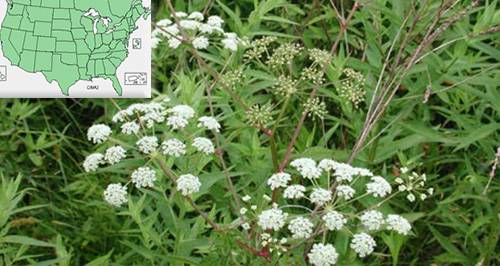
Let me tell you a short but real story that I happen to know… Just so you can understand and identify the exact symptoms:
“A few years ago, a 23-year-old man and his 39-year-old brother were foraging for wild ginseng in the midcoastal Maine woods. The younger man collected several plants growing in a swampy area and took three bites from the root of one plant. His brother took one bite of the same root. Within 30 minutes, the younger man vomited and began to have convulsions; they walked out of the woods, and approximately 30 minutes after the younger man became ill, they were able to telephone for emergency rescue services.
Within 15 minutes of the call, emergency medical personnel arrived and found the younger man unresponsive and with mild tachycardia, dilated pupils, and salivation. He was intubated and transported to a local emergency department. Physicians performed gastric lavage and administered activated charcoal. His cardiac rhythm changed to ventricular fibrillation, and four resuscitative attempts were unsuccessful. He died approximately 3 hours after ingesting the root. His brother was saved.” (Source)
The Water Hemlock is the most poisonous plant in North America. Even a small mouthful can kill an adult.
It can be found alongside the more common, non-poisonous, water parsnip along creeks and wetlands.
The whole plant is poisonous, but the root is the deadliest. Usually cows are poisoned when they pull out the plant and eat the root. One root is enough to kill a cow. If you have this plant on your pasture you need to get rid of it.
Related: If You See This Plant, Whatever You Do Don’t Touch It!
Deadly Nightshade (Atropa Belladonna)
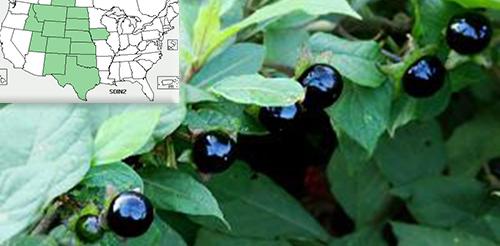
Belladonna (beautiful lady in Italian) was used in Venice by ladies in a tincture to dilate their pupils which was considered more attractive. All parts of the plant are dangerous and can severely reduce mental capacity and agility as well as kill.
Deadly Nightshade’s berries are a serious danger for kids, the berries look edible and are pretty to look at. They are sweet to taste and are at eye level for children. The berries are about the size off cherries and two to four berries is a fatal dose for a child. Ten to twenty are fatal for an adult
Related: 19 Survival Skills You Should Teach your Children This Summer
Belladonna has been used as a poison, dating back to the Roman emperor Claudius. He was believed to have been poisoned with it in 68 AD. Also the Scots are said to have destroyed the Danish army by leaving them tribute of barrels of beer, laced with nightshade.
The symptoms are a red face, dry mouth, dilated pupils and quickened pulse. Later stages turn to heart arrhythmia, tremors, hallucinations, paranoia and cramping.
Castor Oil Plant
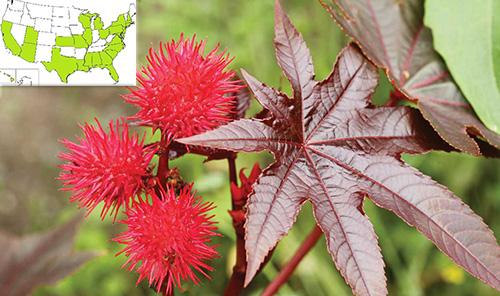
The plant has glossy leaves and coarsely toothed segments.
Castor oil is used in many houses around the world and I have even taken some as a laxative but the seeds are dangerous. They contain a toxin called ricin and ingestion can lead to throat and gastric system burning, a pain and bloody diarrhea and death. The plant is also the Guinness holder of the fastest death.
Related: A Medicinal Plant MAP That Should Be in Your Survival Kit
It is a tropical plant and can easily grow as much as – 9 feet in one season. The seeds that are our concern, grow high in the plant and probably easily out of reach of small children. Removing the seeds from their pods can be challenging but an easy trick is to leave the seeds in a greenhouse over the winter months and the seed pods will explode by themselves.
Two seeds can kill one grownup.
White Snakeroot – Ageratina altissima
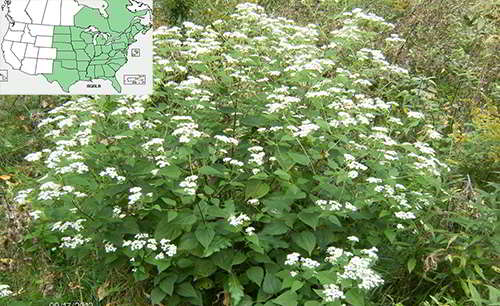
Abraham Lincoln’s mother died from this poisonous plant and there was a widespread case of infection through meat in the 19th century that as known as “milk sickness”.
“A week would pass before Nancy Hanks Lincoln, mother of Abraham Lincoln, succumbed to an illness that had plagued Midwestern frontier families in the 19th century. Records show that more than half of the deaths in Dubois County, Indiana, during this time could be attributed to one plant, white snakeroot. She died at the age of 34.”
This plant contains a toxin that manifests in trembling, vomiting, and seriously intestinal issues. It I also know that even if you eat the meat or drink the milk of a cow that was grazing on White Snakeroot it can cause sickness or death!
White snakeroot is a herb usually about 3 feet tall. Round stemmed and branches with oval, oppositely pointing leaves. The leaves are 3 to 5 inches long and are sharply toothed on the edges. Each leaf has 3 main veins that are very visible on the underside.
White snakeroot is found in any kind of wood and forest and along streams in wooded areas in the US. In the prairie states or provinces it is not often found – except in the woods bordering streams.
Rosary Pea (Abrus Precatorius)
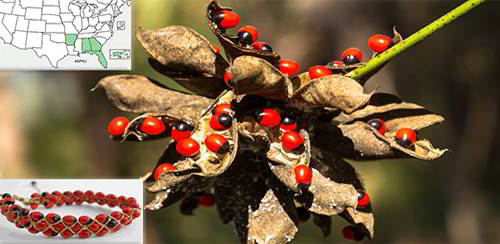
They are called rosary pea because the peas were used to make rosaries, which wasn’t a great idea. The outside of the seed casing is indigestible and there are cases of the pods passing though the digestive tract without harming the person. It contains the toxin abrin that leads to impaired protein syntheses and cell death when opened.
Strangely birds are unharmed by the poison, but apparently one seed is all that is needed to kill an adult.
People have made bracelets and necklaces from the red seeds, and there are in addition stories of people dying from having pricked their fingers while stringing them.
Pokeweed (Jekyll and Hyde Plant)
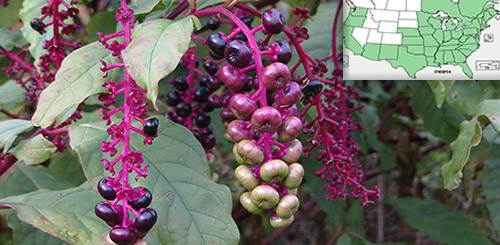
Similar to the rosary pea, this plant has berries that attract birds and are poisonous. The plant grows around 6-8 feet tall with large leaves that have reddish stems at maturity. But as you see from the picture, ripe berries and immature ones grow on the same branch/cluster.
All the parts of pokeweed are poisonous and they contain harmful chemicals. As the plant grows and the berries and the rest of it grows it becomes more poisonous.
Related: The Most Poisonous Snakes in US
Wolfsbane Aconitum (Queen of all Poisons, Blue Rocket, Monkshood, Devils Helmet)
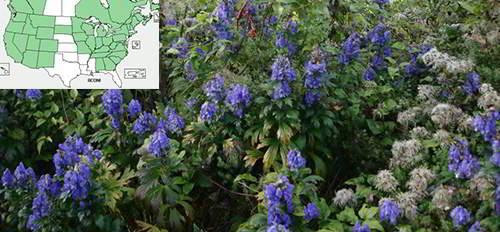
This is an old plant that has been documented and used for centuries in plots and assassinations, and in warfare – to coat swords and arrows.
Some scholars say that Cleopatra was not killed by snake poison but by a mixture that included Wolfsbane.
Greeks poisoned the tips of their javelins before going to war.
Hemlock Conium – Poison Hemlock (Different from Water Hemlock)
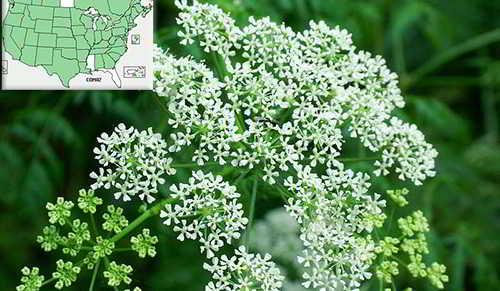
The little plant was used in the Greek world as an execution tool. The ancient Greek philosopher Socrates died eating hemlock.
“Socrates was given the opportunity to suggest his own punishment and could probably have avoided death by recommending exile. Instead, the philosopher initially offered the sarcastic recommendation that he be rewarded for his actions. When pressed for a realistic punishment, he proposed that he be fined a modest sum of money. Faced with the two choices, the jury selected death for Socrates.” Source
The philosopher was taken to the near-by jail where his sentence would be carried out. Athenian law prescribed death by drinking a cup of poison hemlock. Socrates would be his own executioner.
The plant attacks the muscular system when ingested and the connections between muscles. You are paralyzed from the legs up and end up in “ascending muscular paralysis”. Increasing muscular disruption till death occurs. Only around 6-9 leaves or even a smaller dose of the seeds would be enough. It has small white or green flowers and compound leaves and it has large hollow roots. It is often found in moist habitats like marshes or bodies of fresh water, and drainage ditches etc.
You may also like:
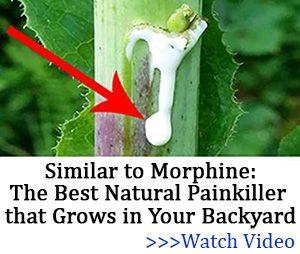 6 Signs Your Neighbor Will Become A Looter As Soon As SHTF
6 Signs Your Neighbor Will Become A Looter As Soon As SHTF
The 10 Medicinal Plants You Need to Have In Your Backyard when SHTF (Video)

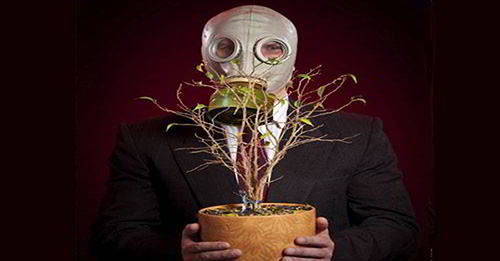













I`ve eaten poke salad my whole live .I know the berrys are poison but are not the leaves ok ?
The whole.plant is extreemly poisonous. However the poisons are water soluable and thats why you boil it and pour the water off. You are litterally pouring the poison away. Properly prepaered and handled poke is a great edible and medicinal.
My great grandmother told a story about a family, they were all severly over weight. They learned about poke then gathered a gunny sack full. Later when she saw them again they were all rail thin. All i can think is somewhere in that time they must not have prepared it quite right and it cleaned em out! (A small dose of unprepared can give you violent diarrhea).
So use the caution and wisdom you were taught when preparing it and be safe.
thank you for your wonderful advice!
Tim, only the small, new leaves are picked. Older leaves are far too strong. Mother brought the fresh leaves to a boil, dumped that first water, then cooked them again in a second water and dumped it. This was strong enough. We added some vinegar to make it taste more like spinach. The root is much stronger; never eaten. very medicinal. Don’t use unless you KNOW.
It’s not the berry that poisonous it’s the seeds. Berries are used medicinally BUT they are swallowed whole, never chewed. Of course you have to know ‘your’ dose as everyone is different.
Finding your dose is easy enough as you take one the first day and two the second and so one until you feel ‘off’ of ‘spacey’ (that’s the seeds which will not digest but will excrete some of the toxin.) Back it up to the day before. So, if 6 makes you ‘off’ your dose is 5.
It’s great for Rheumatoid Arthritis (my husband can attest to that as he was told to apply for SS disability and told he would be in a wheelchair next and now he’s back working construction!) There are other medicinal uses as well… flu being on of them. You need to look up the medicinal uses for the berries and even a root tincture.
KCK Cert. Family Herbalist, Student working on Master Herbalist.
Very informative. Would like to have this important information to view.
Ditto on eating poke. Brings back memories of the old rock and roll song “Poke Salad Annie.” Lived in FL all of my 71 years and was also told that beautyberry was poisonous. That is not true. The berries can be used to make jelly and the leaves and stems can be put in a blender with water to make mosquito repellent.
I’ve eaten poke “salat” for 50 plus years. I’ve only eaten the leaves but have heard of people taking the poke berries as a medicine.
I have eat poke all my life(77yrs) I know some kids that eat the berries I tried them but did not like.I in my freezer from last year now.
I have eat poke all my life(77yrs) I know some kids that eat the berries I tried them but did not like.I have some in my freezer from last year now.
There are more than a handful of dangerous plants although it is certainly helpful to learn about even a few of them. https://www.amazon.com/Wicked-Plants-Lincolns-Botanical-Atrocities/
I taught my children to never eat a plant without showing me first so I could properly Identify it for them until they learn how to ID on their own. I hold wild herb walks and have written about wild edible plants.
My mother would chop up young stalks of Poke weed, roll them in cornmeal, similar to the way you fry okra. It was delicious.